PICTURES AT ELEVEN AT 40/LZ NEWS/ TBL ARCHIVE BADGEHOLDERS LA FORUM1977/BLACK COUNTRY BEATS EXHIBITION REPORT/DL DIARY BLOG UPDATE
TBL Archive: Robert Plant Pictures At Eleven album 40 years gone…
To mark the 40th anniversary of Robert Plant’s landmark debut album – here’s an extensive feature I wrote back in 2002. Pictures At Eleven remains one of the most crucial of his long career and still sounds every bit as exciting and fresh as it did back in the summer of 1982.
Pictures at Eleven – Still vivid at 40…
Robert Plant’s first solo album was a personal career watershed to rival Led Zep 1
For the former singer in the biggest band in the world, the post Zeppelin career rebuilding process can be traced along the highways and the byways of the North of England in the late spring of 1981. Stopping off at Bradford University, the R’n’B ad-hoc line up The Honeydrippers he had established performed on one of the larger stages of their infrequent itinerary. At the soundcheck Plant, sensing the bigger surroundings of the platform, begins warming up with a version of The Beatles. Day Tripper, spinning around at the end of the stage in a once customary manner now seemingly redundant, Guitarist Robbie Blunt comes out of that 6o’s skit and hones down on a descending blues riff… “Oh I dont know, oh I dont know, oooohh yeah,” repeats Plant over the riff. After two or three minutes they stop. “Hey that might be enough for a song” Plant laughs and turns to Blunt. “You never know,” comes the thick Midlands-accented retort.
Within a couple of months during that summer of 1981 Plant and his new writing partner -and indeed sensed the possibilities of a creative partnership that had periodically reared its head in the lighter moments of The Honeydrippers.
As he recalled at the time, “The Honeydrippers had been great fun to do without the usual pressures. Slowly though Robbie and I began to look at each other and realised that it wasn’t going to be that serious so we started writing little bits and pieces in between gigs”.
Joining him at Rockfield Studios in Monmouth was ex-Ashton Paice and Lord bassist Paul Martinez and keyboard player Jezz Woodroffe who Plant had met when inquiring about buying a synth in a local music shop. His past credentials included a touring stint with 31ack Sabbath.
Plant, Blunt, and Woodroffe had already turned in some demos at Plant’s four track home studio – notably Fat Lip with the aid of a Roland drum machine and an excellent Blunt-led mid-tempo rocker Far Post that strangely would not make the final album selection.
The problem of who would fill the drum stool was the biggest dilemma. Plant chose to employ a variety of percussionists. Early demo work even included the then 14 year old Jason Bonham and Bad Company’s Simon Kirke was another initial contributor.
The first recording sessions at Rockfield though employed Cozy Powell – the big hitting drummer who had previously backed Jeff Beck and Ritchie Blackmore. Powell added the necessary backbeat ooomph to two of the more intense compositions – Like I’ve Never Been Gone and the full-throttled Slow Dancer. “Cozy came in like a typhoon. Everyone realised we were playing rock’n’roll. He came in at the middle of it and let fly” recalled Plant.
On a whim Plant then called a pre-mega solo fame Phil Collins – then jobbing Genesis front man and all-round reliable drummer for hire. Collins was more than happy to participate – later taking the drum stool for the first Plant band US tour.
For Plant the whole recording process as a solo artist proved to be an emotional one and there was one seal of approval that he was more than keen to gain. In early 1982 Plant took the completed tape of the album over to Jimmy Page’s Windsor home. “It was an emotional time. We sat there together with my hand on his knee just listening. He knew although about to embark on the first steps of a new career, Plant also found himself confronted with his past. Atlantic had been harbouring for a final Zeppelin album and in the autumn of 1981 Page began trawling the tape archive to assemble what would emerge the following November as Coda. Plant and Jones were both actively involved in the final selection and sleeve design. Plant attended some of the overdubbing and mixing sessions at the Sol adding a new vocal to the ’72 Houses Of The Holy leftover Walters Walk.
In the early spring of ’82, Plant handed over the master tapes of his own solo album and did a photo shoot with photographer Michael Hoppen for the sleeve design. The album would be known as Pictures At Eleven a wordplay on the UK ITV news programme News At Ten.
The album was released on June 25 and entered the Music Week UK chart at number 2 and quickly climbed to the top 3 of the Billboard US listings. The UK chart position was a remarkable feat considering there had been no pre-release single and Plant only gave one UK press interview to Kerrang prior to release.
Though he had yet to formulate any live touring plans he did perform at the Princes Trust benefit show at London’s Dominion Theatre in July turning up with Robbie Blunt to perform Worse Than Detroit from the new album. Plant spent the next few weeks on a promotional tour taking in New York in the summer – his first visit to America since 1977.
He conducted a round of interviews including an MTV chat with long-term Zeppelin DJ associate JJ Jackson.
His whole persona defined the new fresh thinking. The bouffant hair, the casual suits -it was all a long way from the cock-rock poses of a few years back. Then there was his new-found eagerness to court the media – always a no-go area with his former band.
Now there were TV and radio interviews and even a guest spot as a panellist on Mike Read’s Pop Quiz TV show. The visual media age was upon us and Plant was more than happy to embrace it.
Back in the UK he shot a low budget video for Burning Down One Side for Dave Robinson’s Stiff Films which was aired on the Old Grey Whistle Test in September alongside a studio interview with Mark Ellen and David Hepworth.
Though the single made little impression but the album continues to rack up healthy sales on both sides of the Atlantic. It was the inspiration for Plant to retain the momentum and begin recording a second album The Principal Of Moments which was released the following June. Plant then embarked on a lengthy world tour kicking off in the US in August ’83 and taking in the UK, Australia and Japan. His solo career was well and truly up and running.
On the eve of that first tour he reflected on the past 18 months. “One thing about being a member of a close-knit family is that you can never imagine being without it. So when you evaluate your position and what it takes to make you function, you find that the most important thing is to express yourself with whatever the god’s have given you. To that extent Pictures At Eleven will always remain a major part of my life, symbolically if nothing else.”
My Pictures At Eleven
Pictures At Eleven bust into my life amidst the 1982 World Cup. I’d been keenly anticipating its arrival for months. At the time I was ensconced in collating the best material from the first six issues of Tight But Loose which would emerge as my first book The Final Acclaim. I’d had a firsthand report of the album from Robert himself after he had rung me to request I attend a meeting with Jimmy and Robert in Swan Song in March. At their request I brought in various cuttings and pics for them to mull over for what would emerge as the Coda sleeve. “My album is finished and it will be ready in the summer. It’s a new beginning and a re-birth,” he told me that memorable afternoon.
The Warner’s record company rep that called on the WH Smith record outlet where I worked kept me informed of the release schedule showing me a preview of that new stylish image on the cover. A pre-release white label would be with me shortly he promised. He was as good as his word for after calling into work late on the afternoon of Friday 18 June (coincidentally two years to the day that I’d seen them in Cologne) I was working with the good lady Janet back then and it was Janet who informed me the rep had ”left a record for you”
Left a record for me? More like the holy grail!
It was with bated breath that 1 stuck the stylus down on this precious vinyl and awaited the new birth as he had put it. Out came the reassuringly potent Burning Down One Side to usher in a new era.
Initial impressions were most favourable. Moonlight In Samosa and Like I’ve Never Been Gone carried familiar emotional qualities and Slow Dancer was a definite nod back to that field outside Stevenage. Plant’s re-assuring vocal cutting the air “In the darkness, in the darkness, yeah yeah”.
Further excitement arrived with the publication of Kerrang with a cover story interview with Robert and the distribution of the limited edition promo Interview album which came my way via the Warner’s rep.
The album was duly released on Monday 25 June. A week later the Warner rep called in to tell me the album had entered the chart at number 2, a fantastic result – a call to Sain at the Swan Song office confirmed the triumph. As for the World Cup, suffice say England did not share such triumph exiting-left two days after the UK release of Pictures with Kevin Keegan missing that last minute header against the Spanish – curses!
However, there was a major silver lining ahead.
A month later there was an opportunity to see the man on the boards. Robert was added to the Princes Trust charity show at London’s Dominion Theatre alongside Pete Townsend, Madness and Jethro Tull. Robert did a scorching version of Worse Than Detroit with Robbie Blunt on guitar and a house band that included Pete Townshend. It was more than evident he could still command a stage with ease.
There was further activity in the early autumn with the release of the Burning Down One Side 12″ with the brilliant Far Post on the B-side. Plus the screening of the video on Whistle Test. Far Post was top of my play-list in the weeks leading into the winter to be finally side lined by the arrival of Coda… but that’s another story.
Pictures At Eleven was definitely the sound of the summer all of 35 years ago – on the deck before every visit to the pub and in between all those World Cup matches. Snapped in to the Walkman that sometimes accompanied me on my training runs for a half marathon I was then undertaking. From the adversity of the disablement of Zeppelin, Robert had emerged with fresh new music-and a firm indication that the new phase of his career was going to prove very fruitful. It was a reassuring time for Zeppelin fans the world over.
40 years on:
So all these years later I still have much affection for Pictures At Eleven. It retains an innocence and purity somewhat lacking in subsequent Plant solo efforts. Being his first post-Zeppelin music to be released it was an absolute landmark release. It could not have been easy trying to escape the shadow of the past.
The actual recording marked Plant’s first proper studio work since the final Zep album In Through The Out Door three years earlier. In starting anew there was nothing too radical in his approach.
Lining both album’s up side-by-side there are still obvious parallels. Burning Down One Side possesses the rumbling robust pleading of In The Evening. Both Moonlight In Samosa and Like I’ve Never Been Gone carry the melancholy feel associated with All My Love. Worse Than Detroit was the sort of blues-rock-stomp Zep did in their sleep while Slow Dancer offered the epic and dynamic flavour that characterised the likes of Carousalambra.
Elsewhere there were new places to go. Bonzo would have given short shrift to any use of a drum machine -but its deployment on Fat Lip sounded just right for the tune. Saxophones too would not be heard on a Zep album but the late Rav Ravenscroft’s Baker Street-like solo considerably lightened the load on Pledge Pin.
The main difference from ’79 to ’82 was of course the lack of Jimmy Page. Gone were the plangent glides and swooping wide-screen riffs to be replaced by the more refined guitar style of Robbie Blunt. More Chet Atkins than Scotty Moore, Blunt brought his own finger-picking style to the proceedings offering up a more polished sheen courtesy of his use of the Fender Stratocaster
The Kidderminster born ex-Bronco guitarist proved to be an inspired foil for Plant. Blunts no-nonsense pretension-free approach to both his playing and his role as Plant’s new sidekick and writing partner diverted any comparisons with his former partner.
Blunt excelled in providing a free flowing style that allowed the singer to breathe and interpret the songs entirely as he saw fit. Gone was the competitive edge of the Zep era -Plant was now in control and to his credit Robbie Blunt had no problem with that.
Listening to it now Pictures at Eleven still carries a cohesion lacking in subsequent Plant albums. The main criticism I’d harbour is with the actual recorded sound and overall production. Even for the pre-digital techniques of the early ‘8o’s the production sounds incredibly thin. Was it the studio? Plant’s own inexperience in now being hands-on, in the recording process? Clearly he could have benefited from some of Page’s influence as the sonic architect and master producer of all those Zep sessions.
That said, the actual songs stand up very well. Lyrically Plant reflects the vulnerability he must have been subject to at the time. There’s a lyrical starkness about many of the songs that mirror the events and feelings of the time. A rare glimpse into the psyche of the once, and soon to be again, confident front-man. His ego would soon be refuelled via the touring success of the next few years – leading to far less introspection in his writing mirrored in the likes of Doo A Doo, Big Love, etc.
It would not be until the more organic content of Fate Of Nations a decade later that he would return to the more sensitive composition style of this debut album.
Musically too there’s a stark, welcome simplicity in the arrangements. Ahead lay Plant’s perhaps unavoidable, but often uneasy on the ear, preference for 8o’s recording techniques. This would bring forth beat box remixes, sampled percussion, multi-layered backing vocals and synthesiser effects that often came out sounding not unlike a whoopie cushion. Pictures At Eleven retained the power of his past work but not in a glaringly obvious fist clenching way. The songs have an effortless feel throughout but quite complex in terms of construction.
Compare the arrangements on this album to the over-cluttered approach that would rear its head on The Principal of Moments (eg, Stranger Here) and reach something of a crisis with that most difficult of third albums’ Shaken’N’Stirred (eg, Kallalou Kallalou).
Burning Down One side is thankfully devoid of such distractions. It’s straight rock, pretentious rock at that with ample evidence that he could still push his chest out and attack the vocal.
Moonlight In Samosa is built around Blunts acoustic picking – a mid-tempo ballad sung with affection. Pledge Pin hinted at new directions – sparse, urgent and edgy with masterful vocal phrasing, (“As the cavalcade begins to thin do you stop and look around…”) and the best live number bar none of his early tours.
Slow Dancer marks one of the few occasions in that early 8o’s period that Plant faced the shadow of Zeppelin face on, emerging relatively unscathed. What it lacked for in Page finesse, it made up with sheer effort and bravado. “Look I can still do this,” seemed to be the underlying message.
To side 2, track one, and Worse Than Detroit. Clearly Robbie Blunt’s triumph – finger-picking masterfully and chording as required over Plant’s familiar harmonic growl. A blues-rock stomper honed as noted previously on the byways of the North and amongst the backwaters of the Midlands clubs they had frequented when the “Honeydripper was on his way,” to paraphrase the lyric.
The drum machine may have had no place in Zep but it fits perfectly here for Fat Lip which still carries a texture and atmosphere all of its own – and marvel still at that elongated last line “round and round its gonna spi-i-i-i-in”. Blunt again is to the fore putting in strange arpeggio runs with lots of finger stretching.
The anthemic Like I’ve Never Been Gone quickly elevated itself to the main set closer of the early Plant tours. This emotive ballad has worn well with Plant at his pleading best with
The somewhat nondescript Mystery Title is the album’s one real flaw. A jumpy multi-layered guitar romp which proved if nothing else that this type of arrangement was best delivered in the hands of James Patrick. A far better bet for inclusion on the album would have been Far Post. Somehow relegated to the position of the B side to Burning Down One Side. This rollicking Dire Straight-ish swinger with Jez Woodroffe’s piano well up in the mix and some great harmony guitar, remains a delight.
35 years on it’s a timely moment to get re- accustomed with this 1982 first solo release. In terms of the whole Plant career overview, it’s as vital a landmark in the scheme of things as Led Zep 1. Akin to that Zep debut, Pictures represents a breakthrough but on an entirely different level. It was the solo album Plant had never really intended to make. Out of the confines of the Zep safety net it was the moment he had to confront the future on his own.
Whilst it may have been low on production values, the debut Plant solo set clocked in well high in terms of performance and delivery.
He still had it – he could still project it. Pictures At Eleven retains a sense of innocence and purity before the big business kicked back in. It’s an innocence and purity that three and a half decades have done little to erode. That’s why it remains one of Robert Plant’s most durable recorded statements.
Dave Lewis
First written for TBL 16
Here’s the latest Led Zeppelin News Update:
Jimmy Page
- Thunder guitarist Luke Morley said in a new interview that he attended Jimmy Page’s 50th birthday party and that Page is “the most shit darts player I’ve ever seen in my life”.
Robert Plant
- Robert Plant appears to be planning another tour with Saving Grace that will follow his current world tour with Alison Krauss. Saving Grace drummer Oli Jefferson is unable to perform at most upcoming shows with his other band Blue Nation “due to commitments with Saving Grace”. We’ve analysed the tour dates and it looks like Plant could hit the road with Saving Grace from the second half of September onwards. The tour at the end of the year may be connected to the planned release of Saving Grace’s debut album.
- The video of Robert Plant and Alison Krauss performing “When The Levee Breaks” at Glastonbury Festival on June 24 is now available to watch worldwide.
Upcoming events:
July 5 – Robert Plant and Alison Krauss will perform in Rättvik, Sweden.
July 8 – Robert Plant and Alison Krauss will perform at Cactusfestival in Bruges, Belgium.
July 10 – Robert Plant and Alison Krauss will perform at the Royal Park Live festival in Baarn, Netherlands.
July 13 – Robert Plant and Alison Krauss will perform at the Montreux Jazz Festival in Montreux, Switzerland.
July 14 – Robert Plant and Alison Krauss will perform at the Lucca Summer Festival in Lucca, Italy.
July 16 – Robert Plant and Alison Krauss will perform at JazzOpen Stuttgart 2022 in Stuttgart, Germany.
July 18 – Robert Plant and Alison Krauss will perform in Sopot, Poland.
July 20 – Robert Plant and Alison Krauss will perform in Berlin, Germany.
August 15 – Robert Plant and Alison Krauss will perform in San Diego, California.
August 17 – Robert Plant and Alison Krauss will perform in Santa Barbara, California.
August 18 – Robert Plant and Alison Krauss will perform in Los Angeles, California.
August 20 – Robert Plant and Alison Krauss will perform in Stateline, Nevada.
August 21 – Robert Plant and Alison Krauss will perform in Berkeley, California.
August 23 – Robert Plant and Alison Krauss will perform in Napa, California.
August 25 – Robert Plant and Alison Krauss will perform in Bend, Oregon.
August 27 – Robert Plant and Alison Krauss will perform in Troutdale, Oregon.
August 28 – Robert Plant and Alison Krauss will perform in Redmond, Washington.
August 30 – Robert Plant and Alison Krauss will perform in Salt Lake City, Utah.
September 1 – Robert Plant and Alison Krauss will perform in Denver, Colorado.
September 3 – John Paul Jones will perform at the Taylor Hawkins tribute concert in London and Robert Plant and Alison Krauss will perform in Grand Prairie, Texas.
September 4 – Robert Plant and Alison Krauss will perform in Austin, Texas and the Black Country Beats exhibition at the Wolverhampton Art Gallery, which is set to include Robert Plant’s career, will close.
September 6 – Robert Plant and Alison Krauss will perform in Atlanta, Georgia.
September 7 – Robert Plant and Alison Krauss will perform in Franklin, Tennessee.
September 9 – Robert Plant and Alison Krauss will perform in Boston, Massachusetts.
September 10 – Robert Plant and Alison Krauss will perform in Mashantucket, Connecticut.
September 12 – Robert Plant and Alison Krauss will perform in New York, New York.
September 14 – The winners of the 2022 Americana Honors & Awards will be announced. Robert Plant and Alison Krauss are nominated in two categories.
September 27 – John Paul Jones will perform at the Taylor Hawkins tribute concert in Los Angeles.
October – The expanded edition of “Led Zeppelin – Five Glorious Nights” by Dave Lewis will be published.
October 19 – The French translation of “Led Zeppelin By Led Zeppelin” will be published.
December 22 – The paperback edition of “Beast: John Bonham and the Rise of Led Zeppelin” by C.M Kushins will be published.
Early 2023 – “A Whole Lotta Music: Life To My Ears,” the memoirs of Tight But Loose editor Dave Lewis, will be published.
2023 – The remastered and expanded 30th anniversary edition of “Coverdale–Page” will be released.
Many thanks to James Cook
The complete Led Zeppelin News email goes out periodically. To receive it sign up here:http://tinyletter.com/LedZepNews
Led Zeppelin News Website: Check out the Led Zeppelin news website at
To commemorate the 45th anniversary of those six Los Angeles Forum shows of June 1977, here is the first part of a lengthy overview of the 1977 tour that first appeared in TBL issue 9. The pre-amble sets the scene on the state of play inside Led Zeppelin at the time and leads on to a summary of three of those June performances – as heard via the legendary Listen To This Eddie bootleg plus the two Last LA Forum sets issued back in the mid 90s.
Thanks to the late Mike Millard’s superb audience tapes, we can hear lasting evidence of the sheer excitement of the 1977 Led Zeppelin, capturing a week where the sense of on the road fun was never more evident. Read this…and get those 1977 CD remnants on your player…..
1977 AND ALL THAT…….. AND EVENINGS WITH LED ZEPPELIN
BY DAVE LEWIS
PART ONE
Against the background of three of the best live Zep CD’s, some recollections and viewpoints on the state of play as Led Zeppelin made what would be their final trek across America…
“It’s changing now. I mean playing live – that whole stimulus has been missing. When we did that first rehearsal it just clicked all over again. I just feel I’ve cleaned out a load of problems and now I’m ready to get back in the fray, so to speak. Something epic is going to happen musically. That’s what I feel. The next tour. . . you’ll see . . .”
So spoke Jimmy Page at the Swan Song office in November 1976 during an interview with the NME scribe Nick Kent. As can be viewed from the above comments, there was a new wave of optimism around the band as they came back together following the enforced lay off due to Robert’s accident. After all the various promotional interviews for the launch of ‘Presence’ and the ‘Song Remains’ film, the socialising at movie premieres, and the holidaying in tax havens in Montreux and the South of France, finally they were back to what they knew they did best. Playing music.
The formal return to arms occurred in a North London rehearsal studio in the autumn of 1976. And such was their enthusiasm to get back to work this time around instead of re-acquainting themselves musically by easing back in to rehearsals with familiar material of 50s covers – as was the norm on such occasions, they went straight into the fray by immediately attempting to restructure ‘Achilles Last Stand’; for live performance. ‘Achilles’ of course was the killer opening track from their latest studio album. In his ecstatic review of ‘Presence’ in Sounds (possibly the best description of any Zepp album by any critic during their career), John Ingram had noted somewhat astutely if rather blatantly, that Achilles Last Stand’ “would be a motherfucker played live”. It was obviously a notion shared within the band. When confronted with adapting a live arrangement for their multi dubbed epic, Jimmy Page assumed it would require the deployment of the Gibson double neck. Upon rehearsals it was the trusty Les Paul that surprisingly proved most appropriate for the piece, aided by a few timely flicks of the eventide harmoniser.
That autumn’s rehearsals marked Led Zeppelin’s initial preparation for a planned world tour that would open in North America and move to Canada before stretching into South America and winding its way back to the UK. Further rehearsals took place at ELP’s Manticore Studio in Fulham in the early weeks of 1977. Here the band developed a totally new set list, reviving the long deleted full acoustic set and rearranging tracks such as The Battle Of Evermore’ and ‘Ten Years Gone’ for their debut as live performances. For the latter track Jonesy brought in a new custom made three necked guitar while Jimmy toyed with the idea of playing pedal steel guitar on stage (an idea that was eventually dropped). For Robert they brought in a new toy – a vocal harmoniser that allowed him instantly to double track his voice. Much planning went into creating a balanced programme that would present a new look to America. With no new album to play alongside the tour (‘Presence’ being a year old already), the group took to the road to present what they would ultimately dub simply as An Evening With Led Zeppelin’.
The Fulham rehearsal location allowed them to venture into central London at night to view the then emerging Punk scene – checking out the likes of The Damned and Easter at the Roxy club in Soho much to the bemusement of the UK rock press. Visitors to the rehearsals in Manticore include Billy Idol and Generation X and Steve Marriott – the latter jamming with them on old Muddy Waters numbers, an experience that freaked Robert out – such was his admiration for the late, great ex-Small Face and one time number one choice as a vocalist during Jimmy’s attempts to get the first Led Zeppelin incarnation off the ground in 1966.
By the end of January the set had been honed to perfection and Robert, aware of the physical demands about to be put upon him tor the first time since his accident, booked in a weekly bout of training with the Wolverhampton Wanderers soccer team. Everything was set for a Feb 27 opening at the Convention Centre, Forth Worth, Texas and their equipment was meticulously packed and airlifted to the Showco HQ in Dallas for a final PA test. Then the troubles started.
In early February Robert contracted a severe bout of laryngitis and the tour schedule was postponed. During the next few weeks the tour itinerary went through various revisions. At one point they looked set to hit Toronto on April 1 and the West Coast in the summer. Eventually that idea was scrapped in favour of them opening in Dallas on the same day. Back in the UK, Earls Court promoter Mel Bush was hopeful of persuading Peter Grant to secure the group to top a one day festival due to be staged in late August at Wrotham Park near Potters Bar. It was to be an entirely unsuccessful quest as their US commitments beckoned.
With all their equipment in America including all of Page’s guitars, there was no room for further rehearsals leading up the opening date. It was therefore a very nervous Led Zeppelin who gathered in the wings of the Dallas Memorial Auditorium on the evening of Friday April 1 1977. (For visual evidence, take a look at the group photo from Neal Preston’s ‘Portraits’ book which captures the moment – also reproduced on the ‘Coda’ gatefold sleeve). So many questions remained unanswered in their minds. Would Robert’s injured foot take the strain? Would the long gap between rehearsals affect their co-ordination? And would America still crave for Led Zeppelin as they had done in previous years? . . . They really needn’t have worried.
From the moment Page slayed across the double neck to pick out the chords for the newly ensconced opening number ‘The Song Remains The Same’ that spring evening in 1977, it was plain for the group and its entourage to see that America’s love affair with Led Zeppelin was far from over.
From Dallas the tour progressed to Oklahoma and a four night stint at the Chicago stadium. From there the statistics began to blur. 40,000 in Cincinnati over two nights, 36,000 in Cleveland – leading to the remarkable 76,229 who attended the group’s appearance at the Silverdome Pontiac in Michigan on April 30 1977. This set a new record for a single act performance beating the previous best of 56,800 who had attended a concert at Tampa, Florida by . . . Led Zeppelin’.
In early May the group split for a two week break. Jimmy spent a four day holiday in Cairo, returning to be in attendance for the presentation of a prestigious Ivor Novello award along with Jones, Plant and Grant at London’s Grosvenor Hotel. By then the tour reports that had been filtering back to England had certainly fuelled my own curiosity to find out just exactly what they were up to. Reviews of the show from Chicago and St. Louis in Sounds and Melody Maker revealed the introduction of Ten Years Gone’, ‘The Battle Of Evermore’ (with Jonesy on vocals), the medley of Black Country Woman’ and ‘Bron Y Aur Stomp’, Jimmy’s guitar solo leading to ‘Achilles Last Stand’, and the link of ‘White Summer’ played live for the first time since 1970 leading to ‘Kashmir’.
With little hope of them playing in the UK, I hatched a plan to fly to New York to catch one of their June Madison Square Garden gigs. This being way before the days of organised overseas rock concert travel (and cheap shuttle air fares), the sheer economical logistics made the idea impossible – despite much assistance from Swan Song’s Unity Maclean to arrange tickets, etc. Instead I decided to wave them off from Heathrow as they flew back to America on May 17. Calling in to the office earlier in the day, I was despatched to find a copy of that day’s edition of the London Evening Standard from the local King’s Road newsagent. The reason was for Swan Song to check that a retraction of a story printed on Monday had been inserted.
The story centered on an alleged incident involving Robert Plant being arrested in Atlanta for pulling a knife and being drunk at Hartsfield Airport. The story was actually perpetuated by a 19 year old youth impersonating Robert – who on the day had been horse riding in Wales! The retraction was printed with an apology which was duly telexed to the Plant home.
A few hours later I arrived at Heathrow’s Terminal 3 and met up with the group and entourage as they awaited the call to fly to Alabama. Robert was on peak form, talking to all and sundry and sending up the late arriving Jimmy (“Where’s Patti Page Colesy?”) displaying a swagger and verve that would never quite be the same after this tour. Jonesy, resplendent in a Union Jack cardigan, happily posed for photos and unfolded tales of the three necked guitar. Bonzo seemed a little nervous and detached, anxious to get away. Jimmy arrived late in a misfitting white suit, sweaty and unshaven, hardly a picture of health, but ever articulate and anxious to meet with Robert.
Above -The young DL with half of Led Zeppelin – Heathrow Airport May 17 1977 – Note dinner plate size Led Zep badges on wide lapelled jacket.
20 hours later they were back on stage at the Coliseum in Birmingham, Alabama. The remarkable cine home movie footage that has surfaced from that show illustrates the transition that Jimmy underwent once on stage. On that scratchy film he is literally everywhere, duck walking, dropping to his knees, spinning, turning … the perfect toil for Robert to narcissistically weave between. That Birmingham cine film certainly hones in on the two contrasting images of the tour. On stage they were capable of supreme moments, but off stage all was not so well. The state of health of Jimmy Page was a high topic of contention amongst the entourage throughout the tour. Indeed the second of the four Chicago shows had been cut short when Jimmy collapsed during Ten Year Gone’. This lapse was put down to food poisoning – Page having stated on the day of the gig that he was having trouble arranging a healthy diet on the road. Other problems centered on the addition to the security set up of London criminal John Bindon which caused much unrest amongst the roadies. His presence would of course have even greater consequences when they reached the Oakland Stadium in July. . . It would seem that being the biggest band in the world dictated that they had to have the most notorious minders … the most outrageous road crew behaviour… and of course the most amount of drugs.
Perhaps then it’s even more remarkable how impressive their performances and Page’s in particular could be during this era. It was as if each member of the band possessed an inner strength that drew and fed from their collective power. No matter what craziness was happening off stage, somehow as soon as they faced their audience something clicked. Not that it clicked without some inconsistencies showing through. As on any tour some nights were distinctly better than other nights. As an example – though just days apart, the difference in, say, Bonzo’s performance at San Diego on June 19, where he is surprisingly uncoordinated at times, is fairly striking compared to his domination at the LA shows. No doubt the old road fever was taking effect. The indulgence of certain parts of the set also made for a lack ot urgency. Brian Knapp tells me of the atmosphere of the 77 shows he saw pales against the more intense drive of ’75. The marathon excess of ‘No Quarter’ and ‘Over The Top’ often inspired a mass walk about for certain sections of the audience, unable to focus on the stage for too long amongst the excitement. The repeated problem of firecrackers being thrown at the stage also angered the band – culminating in Jimmy having to stop playing for treatment after being struck on the arm at one show.
As the second part of the tour rolled on, they were all eying with much relish the thought of settling in to the late June string of LA shows. After the trauma of the abandoned date in Tampa when rain stopped play after 20 minutes, matters improved for a six night run at Madison Square Garden. This latest triumph was faithfully reported back to the UK via a centre page spread by Ray Coleman in the Melody Maker issue of June 25. (I vividly remember rushing into the newsagent and excitedly buying up a bulk lot of copies to see how it was all progressing.) By that date they were back in their second home for what can be viewed in retrospect as their last truly great US appearances – and some of the very best of the post 1972 era. And thanks to the delights of those silver rarities, such performances are now available to reassess at the flick of the CD scanner button – providing the listener with the opportunity to travel back to the LA Forum and share again in the madness of the 77 tour.
When it comes to the underground documentation of this era, there have been a crop of ‘releases’ over the years. Many fans will already be familiar with The Destroyer’ soundboard April 27 Cleveland show, which is fine in itself but not the most inspired performances of the tour. 20 more minutes of soundboard quality exists from the June 11 Madison Square show (available on the ‘Silver Coated Rails’ CD) and the other prize catch up to now has been the two volume vinyl doubles ‘For Badge Holders Only’ capturing material from the June 23 LA show including the Keith Moon jam.
Listen To This Eddie’ was previously available on two hard to find vinyl sets. Now for the first time, the whole of this dynamic opening show from LA June 21 1377 is packaged on three CDs with a total playing time of 190 minutes. The sound source is from an audience tape – but it really is an excellent recording – very clear and over spilling with the sort of auditorium atmosphere that cleaner soundboard tapes often lose. The visuals for the inlays are also first class being reproductions of the photos to be found in the 1977 Tour programme.
‘Listen To This Eddie’ is very much the genuine article. A complete Led Zeppelin concert experience, a thrilling aural record that puts you right there on the spot.
The pure excitement of the event is evident from the moment the exuberant crowd noise filters through as the first CD commences. If there was one period in Zeppelin’s live concert history that I could be magically transported back in time to relive, then right now I would select the moment captured here when the group walk on to the stage for this opening LA Forum 1977 date. The expectation level must have been immense. Bonzo is the first to be heard rumbling the Ludwig into action. Then Jimmy scrubs his hands over the Gibson double neck to tease the crowd with a few well chosen chords. Those tantalising warm up chords became something of a Zep on-stage trademark when they employed ‘The Song Remains The Same’ as a set opener post 75. It was the same tactic we home-grown fans would finally revel in at Knebworth two years on.
Those chords eventually mould into the stinging intra of ‘The Song Remains The Same’. Immediately your senses are further assaulted by the quite brutal percussion of John Bonham. He rides alongside the galvanised guitar effects eventually breaking into the most inscrutable snare roll that underpins Jones’ bass patterns and Page’s role to emerge as the pivotal effect of the whole track. From that moment on, his playing dominates the proceedings. As I earlier observed, his performance a few days earlier had been decidedly lackluster in San Diego. Plant later explains he has just recovered from a bout of food poisoning and it’s obvious in LA John Bonham is back firing on all cylinders. The ‘Song’ swings into ‘Sick Again’ via ‘The Rover’ riff link as was commonplace at the time. They take a while to get into the groove here, but eventually with Robert teasing the crowd the momentum is increased leading to an extended outro that finds Page reeling off a series of telling phrases. “Good Evening” says Plant sedately before a more celebratory “I mean Good Eveeeening! Well, we finally made it. Haven’t seen you since. …. Anybody here when we played with Bad Company? That was the first time we ever managed to get back on stage again … So tonight no beating about the bush. We’re just gonna play ‘coz that’s what we’re here for.” But before they play there’ a pause of over a minute as Jimmy gets in check. Then it’s ‘Nobody’s Fault But Mine’ and again it’s a Bonham led fusion as the drummer blisters alongside Jones and Page on this most intense dynamic excursion. Plant meanwhile screams and grapples with the stuttered lyric.
There’s a telling no-nonsense stance about Plant’s next introduction. “It is indeed a great pleasure to be back in California for many many reasons, among those it’s very hard to see the sun in a basement in New York. This is a song about. . . well, it’s not even worth telling you what it’s about. YOU know!”. That statement says much about the affinity the group shares with its LA audience. Plant knows and they know that this is the tale of the passage of man . . . ‘Over The Hills And Far Away’. One of the few inflexible parts of the 77 set, this number was brought in at the June Madison Square stint and was employed in rotation with ‘In My Time Of Dying1. One of my all time fave live pieces, it’s good to hear it in this setting. Jonesy’s eight string Alembic patterns can be heard very clearly and Jimmy steps on the eventide to double up the effects of the solo – which is not quite as impressive as the June 23 ‘Badge holders’ cut but mighty fine nonetheless. “That was a song that speaks for itself. This is a song that comes from what you might call the urban blues of the United Kingdom. A song that you probably already know but a song very close to all of us in the band from time to time and things like that.” The ’77 incarnation of Since I’ve Been Loving You’ as captured on the opening LA show just might be the version to live or die by. The reason is simple. Jimmy Page’s playing throughout is just so precise, with every lick charged with vivid intensity. Over which Plant delivers a flowing vocal and John Bonham again delivers a truly devastating performance. Just marvel at the closing coda as he scatters his arms around the kit forming a barrage of power and glory.
“Welcome back to the world, John Bonham, who had a terrible fit of food poisoning”, acknowledges Plant. “He’s been taking too many rhinestones. That by the way featured Jimmy Page on guitar. . .” The noise and sheer bravado that greets the latter statement is quite startling, prompting Plant to later mimic the crowd any time they begin to get out of hand. “I didn’t say Jimmy!”. “No Quarter’ follows, the first of the marathons. The ’77 version for me suffers from just a little too much instrumental freedom as Jonesy romps through boogie woogie and neo- classical themes before Page returns to add some undisciplined guitar work.
One interesting addition to the song is the “Dogs of doom are howling more” refrain which finds Plant in a call and response mode with Jimmy during the final movement. This arrangement was retained for Knebworth and even survived the rather bizarre Plant solo rendition employed on some of the ‘Manic Nirvana’ 1990 shows. A final observation here: when one considers the song’s gruelling half hour length, it’s perhaps not too hard to see why it inspired some restlessness amongst the crowd. ‘No Quarter1 lacked the visual anything-could-happen appeal of the other lengthy live opus Dazed And Confused’ and it pushed I’d take the compact ’73 version and the majesty of the Earls Court deliveries over anything performed post 75.
Robert battles with the restless crowd (“I didn’t say Jimmy!”) to explain that the next track came out of rehearsals as they looked to perform material they’d previously ignored. “Jonesy most kindly went out and bought a three necked instrument which since then has often hurt his back in many a hotel, so with the aid of Jonesy’s three necked instrument we’re gonna try a thing from ‘Physical Graffiti’ called Ten Years Gone’”. Robert delivers an outstanding vocal here set against some immensely fluid Telecaster work from James P. Unfortunately the effect of this track is then marred considerably by an untidy fade and edit at 5.28 into the song which misses part of the final verse. The acoustic set is thankfully all intact as Robert sets the scene. “It brings to the front of the stage a man who had a very bad stomach complaint – John Bonham. The Rhinestone Cowgirl. I guess he’s a Cowgirl In The Sand . . .” The latter reference inspires a “bring on Neil Young” plea from a wag in the crowd. Instead they perform The Battle Of Evermore’ with Jonesy on vocals and Bonzo hitting the tambourine with gusto towards the end.
“This next song we should dedicate to a lot of good friends we’ve met along the way, some are going back to New York tomorrow . . . Dear Danny (Goldberg?), we’ll miss you so much and your American Express card. Lots of good people who we’ve met – especially the people who made us write this song (wah).” ‘Going To California’ is noticeable for yet another Joni reference (“They say she plays guitar and cries and sings and she lives in Bel Air”). “I wonder if she still lives there”, he can be heard to mutter off mic after the song. A couple of teasing choruses of ‘Hangman’ from Robert ushers in the medley of ‘Black Country Woman’/’Bron Y Aur Stomp’, which then leaves the stage to Jimmy Page. From the delightful opening strum of the modal tuned Dan Electro he turns in an aggressive solo rendition of ‘White Summer/BIack Mountain Side’. Played faster compared to the rather sedate politeness of the box set BBC version – and for the first time in LA for seven years, it builds the tension before swinging directly into ‘Kashmir’ (another ’77 set ritual that stayed with them for the rest of their touring days), Unsurprisingly on this occasion it’s Bonzo who again comes to the fore adding the power to match Robert’s impassioned final pleading.
Moby Dick’ re-titled ‘Over The Top’ for the marathon delivery on this tour is preceded by an hilariously obnoxious Plant introduction as a delay occurs in setting up. Witness: “That was called Kashmir… Let me take you there. Bit of trouble with the musical equipment here. Right now the man who fought against the elements. The man who fought food poisoning. The man who drinks Heineken . . . The man who doesn’t get out of bed . . . the man who hasn’t got a cymbal . . . the man who’s having a chat with this man who knows the man who tunes Jimmy’s guitar and comes from Scotland and doesn’t know the man they call Tim but does know Audrey from Dallas thank you. The man who now learns to construct his own drum kit . . . the man who’s not very professional . . . shudd-up wait a minute … the man who said he could go back to a building site anytime and we all agreed … the man who’s holding up the show … the Rhinestone Cowgirl . . . C’mon Bonzo get on with it … the man who played the Los Angeles Aztecs and beat them 10-1 by himself. . . C’mon you silly fucker. . . the man one wonders is he worth waiting for. . and doesn’t realise there’s a curfew here … a childhood friend .a man who many people once said . . never heard of him . John Bonham Over The Toppppppll!” It’s an introduction that hones in on the off stage silliness of this part of the tour. Over The Top’ is just that as Bonzo powers on and on
Next up a rare ’77 tour bonus. Heartbreaker’ made only fleeting appearances in 1977 first being introduced on the June 10 Madison Square appearance. Predictably there’s a genuine desire to perform it for the LA crowd and it positively leaps from the speakers. Bonzo brings a subtle difference to the Page solo by serenading the high neck guitar chops with a crash of hi hat and snare. On into the home straight Page performs the showpiece ‘Guitar Solo’. This opus signified the end of ‘Dazed And Confused’, as it incorporated the violin bow episode into a lengthy solo extravaganza. Obviously more of a visual piece, it does make for some decidedly uneasy listening as Page attains an abusive howl of noise from the guitar. ‘Star Spangled Spanner’ performed with a nod in the direction of James Marshall Hendrix moves into the bow episode which eventually makes way for the introduction of ‘Achilles Last Stand’. Needless to say this is yet another Bonzo tour de force. After that it’s Robert’s closing speech. “Achilles Last Stand … at least we thought . . . very nice to see some friends just arrived from England – Mr. Phil Carson, a man who played bass in Japan with Dusty Springfield a long time ago. See we know all the Oldies (off mic) and all the pushers!”
“Well no doubt you picked up on the atmosphere at least on stage tonight. It’s like a high point of the whole tour to be back here. Maybe after six nights it may not be so easy to say that but at the moment …. we give you this song . . . .” ‘Stairway To Heaven’ ’77 style includes some great ad libs (“Does anybody remember forests?”) and moves its way into an evocative Page solo. Rigorously crafted against Bonzo’s hi hat jiggling it moves through rock, flamenco and Latin influences and includes that great moment when everything just stops . . .
As the kids froth . . . it’s an apocalyptic encore medley of Whole Lotta Love/Rock And Roll’ that bursts forth with a great repeated and harmonised final “Lonely Lonely Lonely” refrain which leaves a breathless Plant to wave farewell. “LA, it’s like a good woman – Good Night!”
And that was only the first night. As a complete concert souvenir, ‘Listen To This Eddie’ is probably the most authentic slice of live Zep explosion packaged for the underground market since ‘Blueberry Hill’, and I can think of no higher recommendation than that.
Dave Lewis
Part Two to follow
It’s a Happy Birthday to Mr Dave Ling… insightful music journalist and football chronicler, long-time supporter of my TBL mag and Zep books and all round top man – Happy Birthday from the good lady Janet and I – have a great day mate!
Saturday July 2:
Saturday is platterday…on the player marking it’s 40th anniversary this week –the debut Robert Plant album Pictures At Eleven and sounding fresh as ever – this copy a US promo – I have a few!
Saturday July 2:
Sunday sounds on CD – it’s a bit of a Stones day here so loading up the superb 2015 2 CD/1DVD box set re package of the Sticky Fingers album – one of their very best…
We couldn’t make Hyde Park yesterday but the good lady Janet and I did have great fun spinning plenty of Rolling Stones records here when our very good friend Jenny visited – including selections from the rather iconic albums on display….
Update here:
Within a bit of a tricky week here there’s been more work on the DL memoirs and some selecting of additional images for the revised Earls Court book project. It was also good to catch up on the phone with long term Zep collector and TBL contributor Steve Jones and esteemed record collecting comrade John Parkin. As ever, there’s been plenty of much needed musical inspiration and along with the above selections here’s the current DL summer playlist:
The Rolling Stones – Rolled Gold 2 CD
Graham Nash – Songs For Beginners/Wild Tales Live 2CD
David Hepworth’s Deep 70s Cuts -Underrated Cuts From a Misunderstood Decade (4 CD set)
Dusty Springfield – See All Her Faces 2 LP Record Store Day release
The Sweet Rare Platinum 2 – 2 LP Record Store Day release
Yes – Essential Collection 2 CD
Dave Lewis – July 7 2022
Until next time…
TBL website updates written and compiled by Dave Lewis
Follow TBL/DL on Facebook:


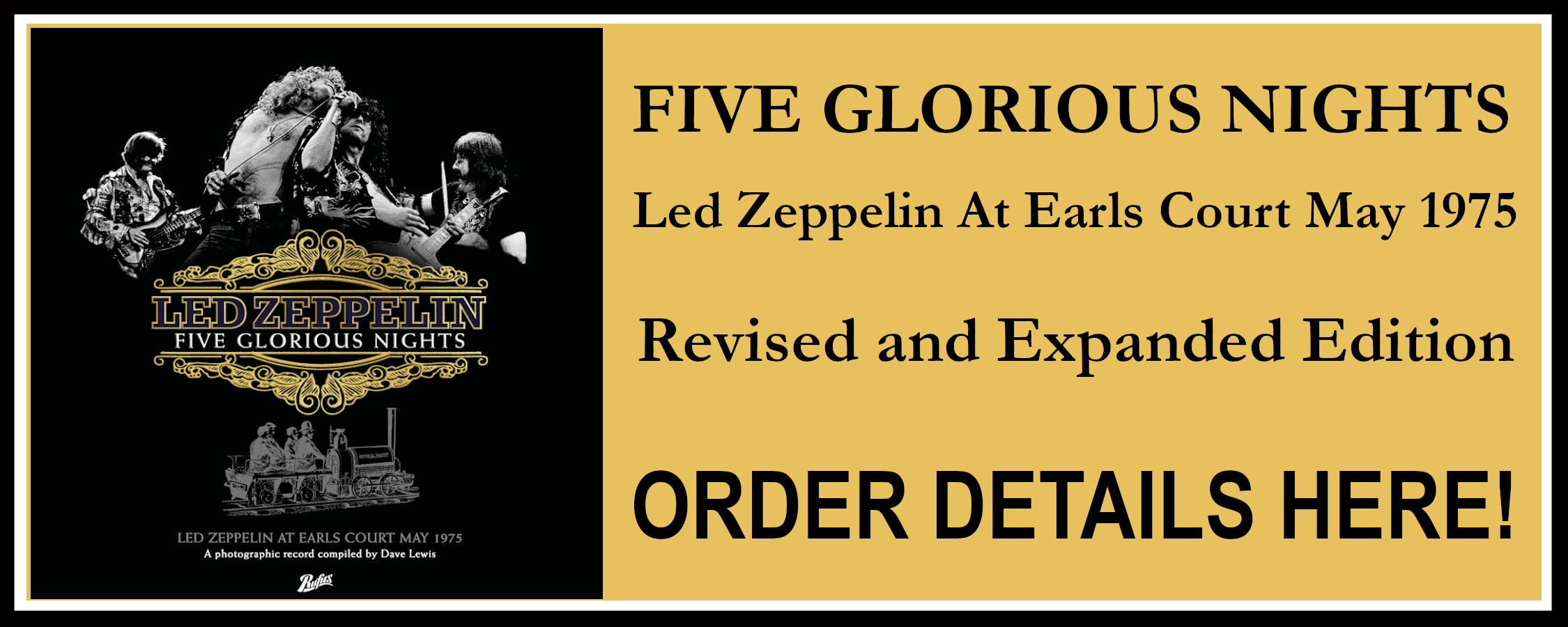



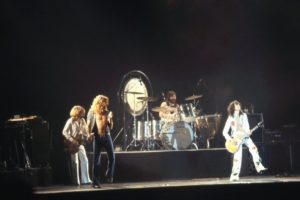
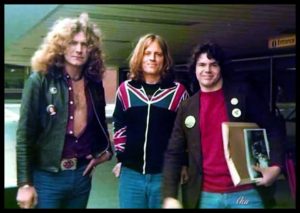
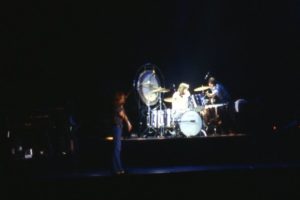
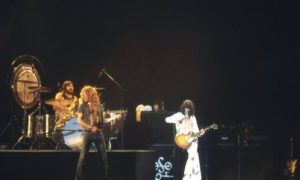
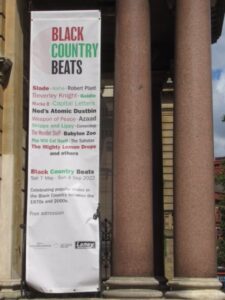
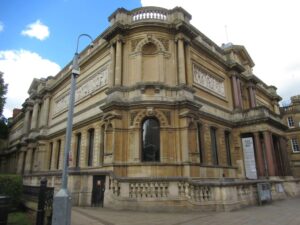
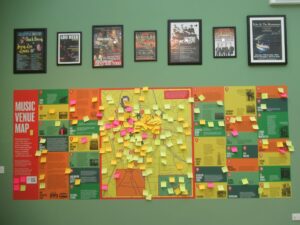
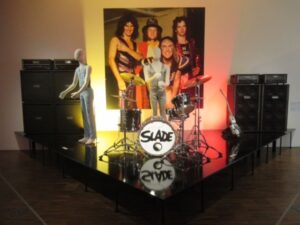
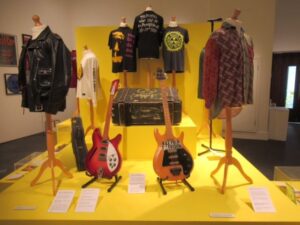
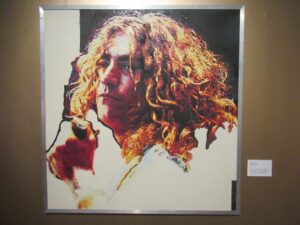
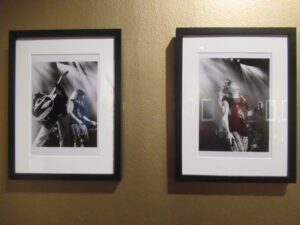
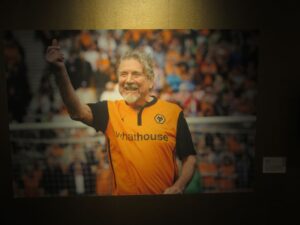
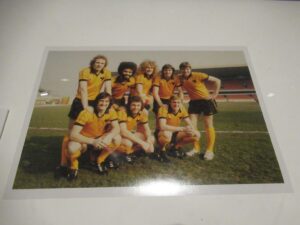
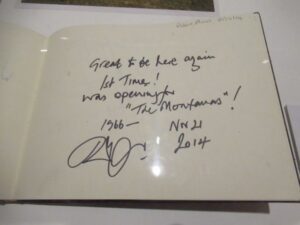
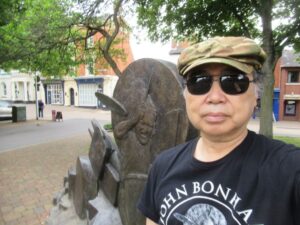
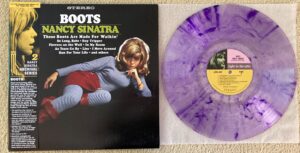
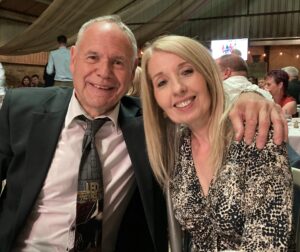
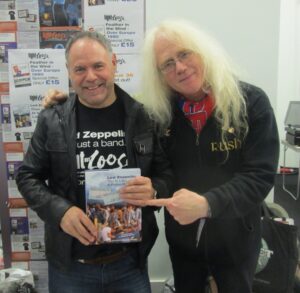
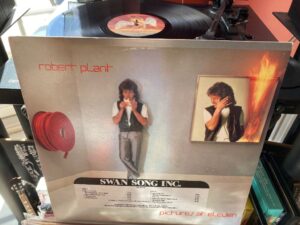
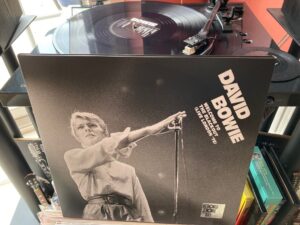
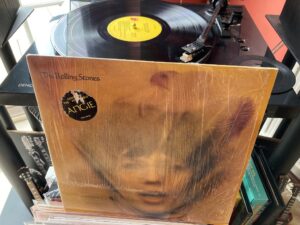
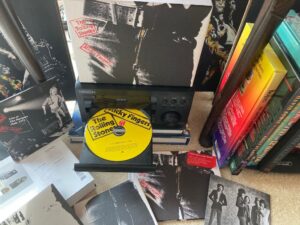
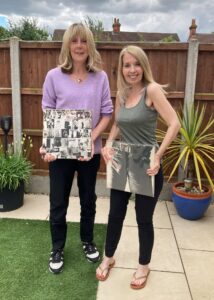
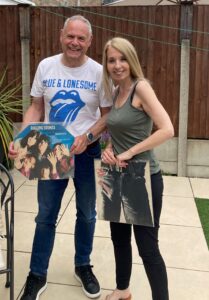









What a night, back in June of 1982…
WRIF in Detroit was going to premier the first solo record of Robert Plant since the end of Led Zeppelin. I was ready, fresh Maxell cassette duly loaded in the tape deck of my (ahem) SoundDesign all-in-one audio fortress of a stereo system. (Bonus: It could record 8-track tapes, too).
The program began. The record lever was pressed. And the strains of Robert and his new cadre played into my suburban bedroom that summertime evening in 1982. No computers or devices in those days to distract. Instead, I likely sat on my bed perusing comic books or simply staring out my upstairs window to the west. I do recall it was dark, but in that latitude, twilights linger well past 9PM that time of year.
I don’t recall much of the evening, but I knew I liked what I heard… and what I felt, too. Especially the unexpected tracks like Fat Lip, Moonlight in Samosa, and Like I’ve Never Been Gone. And, as something of a sax player myself, Pledge Pin was quite a snazzy curve ball to revel in. (Especially humorous was learning that one track’s title was “Worse Than Detroit” and realizing Plant was also a fan of the movie, “Airplane!”) Mystery Title’s vibrance and reckless abandon, culminating in that full-on stop, seemed to perfect the entire experience; it’s attitude and gumption arousing the same spirits of WKRP in Cincinnati’s silly but fitting end-credits song.
Granted, in those years I had but a nodding acquaintance with Led Zeppelin, having peers more attuned to Rush, Yes, Van Halen, and others. Journey’s Escape album (and title track) was the first to grace the SoundDesign’s turntable the prior autumn to christen this 16th birthday gift (with the ambiance of that particular song proving quite immersive).
To record Plant, then – this singer of great renown’s new work – was intended to impress my two older brothers. The soundtrack of their teens radiated Bowie, Edgar Winter, Trower, Nugent, Alice Cooper, The Who and – of course – Led Zep. Apart from Bowie, I wasn’t as aligned with them, deferring a bit more to my sister’s tastes, ranging from The Carpenters to The Babys and – of course – Journey.
Suddenly, though, there was this: Pictures at Eleven. I felt like I’d found something for me, a sound that I related to and one I didn’t quite inherit. Sure, it emerged from the 70s bombast of my brother’s vinyls but unapologetically danced with some of the sonic sentiment from my sister’s (much more elegant) Phillips turntable. It didn’t matter that my brothers were unimpressed or that my sister gave little more than a nodding smile upon hearing it. I liked what I heard and felt. And it was mine.
It served as a soundtrack to the summer and fall, meeting up with Rush’s Signals in September on mix tapes. Like Plant, Rush were moving past their past and embracing what comes next. Unlike the legacy bands and artists my older siblings followed, Plant and Rush frequently accompanied me as I began to drive and explore the roads that lie ahead through the 80s.
As the soundtracks of the past year faded from newness as the summer of 1983 settled in, I found myself sitting in our church’s parking lot one Saturday afternoon. I was a bit early for a youth activity. The other Detroit rock station, WLLZ, kept me company in the hot July sun. To my delight, the DJ announced three tracks from the forthcoming album by Robert Plant. As only the first single had been released I was suddenly glued to my seat…
When Open Arms began to fade from the speakers of my dad’s 1976 Oldsmobile 98, a gentle crescendo of strings and bass drifted along as In The Mood began. The song simply made me happy. As Woodroofe’s personal symphony reprised to fade the song away, the open tones of a pensive Strat sauntered into the passenger seats as Robbie’s signature work, Big Log, set the compass for Robert’s voice to drive onward.
I liked what I heard… and what I felt, too. All over again.
It was mine.
And a generation later, it’s all still very true.
Thank you, David, for keeping it all aloft and alive with such keen insights and stories from the other side of our own experiences!
It still often Pictures, Fate, and ReArranger jockeying for Win, Place and Show in my book.
pictures was a great solo debut from robert its stood the test of time
Hi Dave,
Reading about Plant being actively involved in the sleeve design for Coda brings memories flooding back about my first meeting with the great man. It’s a long story (which I would be happy to write about for TBL in detail), but – cut to the chase – I was with Brian Knapp and Mark Harrison when they went in search of ol’ Percy to retrieve photos they had lent him for the LP sleeve. Remarkably, we found him at his local pub – and he invited us all back to his place. Teenage mind totally blown. I was 17. Brian and Mark, if you are reading this, I have one solitary photograph from that legendary day. Do you have any you could share? I would really love to see them (no doubt Dave would facilitate a connection). Mind blown again just thinking about this…
Great and insightful comments on the first solo Plant album, Dave.
Pictures At Eleven was one of four vinyl albums I bought with my first ever pay packet, on Saturday 9th July 1988. As a Zep-obsessed teenager I had reached that point of owning all their studio albums but still craved more, and solo albums seemed the next logical step.
It was strange hearing Plant’s voice – so instantly recognisable and familiar – with music that wasn’t Zeppelin. That took some mental adjustment. Having listened to Led Zeppelin constantly and intensively for the previous three years it took a while to disentangle Robert’s voice from Jimmy’s guitar and just relax and go with it. Sounds stupid, but at the time I almost felt guilty for liking Pictures At Eleven.
Leave your response!
TBL Products
About TBL
Tight But Loose Website edited by Dave Lewis and Gary Foy.
Tight But Loose Magazine created by Dave Lewis 1978. TBL/Web launched by Dave Linwood 1995. TBL logo by Mike Warry.
All written material and photographs are copyright © Tight But Loose. Not to be reproduced without prior permission.
Tight But Loose welcomes input / info / tour reports / CD reviews / CDR’s & Tapes on any Zep related topic past and present.
Archives
Recent Posts
Recent Comments
Tags
Views